There are some aquarists who just prefer keeping small body-sized fish in their aquariums because they like to have just small tanks in their homes. Small fish that will grow to less than two inches and can perfectly fit in aquariums which are as small as ten gallons are classified as Nano Fish. They come in variety and it remains up to the aquarist to choose those he/she prefers to have in the aquarium. Nano fish are not that easy to care for and therefore should not be the fish of choice for the beginner though.
Table of Contents
Nano fish for Nano tank
If you have a small space so that it cannot be sufficient for a larger tank, then opting for a small sized tank that can easily fit on a desktop is preferable. Even though having a Nano Aquarium will come as a big reprieve for you especially if you don’t have much space, finding the right fish that will fit in there may be a herculean task for you. Here in this article we are going to discuss with you some of the best Nano Fish you can possibly collect and introduce to your small-sized aquarium.
The Scarlet Badis (Dario dario)

The Dario Dario, also known as Scarlet Badis, has an Indian origin, and to be more precise about their habitat, they can usually be found near the Brahmaputra River!
Scarlet Badis is an elegant nano fish that looks somewhat similar to dwarf cichlids but surprisingly they are not related in any way. It is usually very peaceful and will live in a community tank with other fish of same size and temperament. They can be particularly tricky to feed due to their shy and timid nature. This therefore calls for the aquarist to take extra care to ensure that they eat what they are offered to eat. Among some of the foods they will gladly feed on include; live brine shrimp, daphnia, and banana worms. It is best not to feed them foods such as tubifex worms, blood worms as these kinds of foods tend to make them prone to disease.
Scarlet Badis Care And Tank Conditions
When it comes to Dario Dario, it is evident that this fish species does not require high-end care and maintenance! A minimum to standard maintenance will be enough for the fish to thrive and flourish.
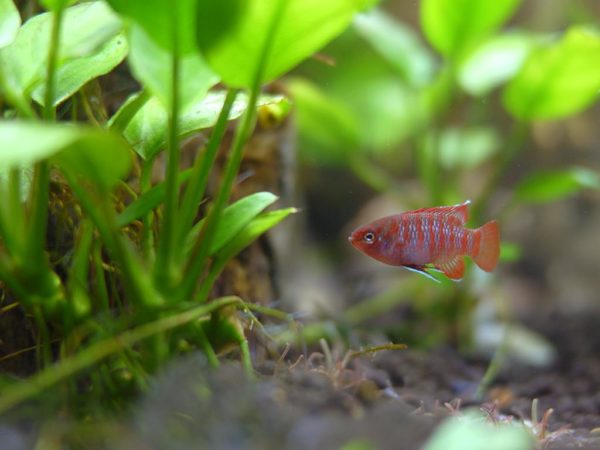
These fish are comparatively smaller and can fit in a relatively small tank. These fish are pretty hardy in general terms, and if you wish to keep them free of infections and diseases, always keep fresh water!
Scarlet Badis Temperament And Behavior
Dario Dario or the Scarlet Badis can be very peaceful, but the issue arises when you have too many of them in a tank! Males can be very territorial.
Scarlet Badis Diseases
Dario Dario is known for its hardy nature and suit to a vast number of water conditions! However, these are still prone to some diseases, such as Ich. If you fail to keep the water right, your fish will be affected by Ich disease.
Poor water conditions can result in causing Ich, and it can severely weaken your fish’s immune system. Both recovery and treatment procedures are there! You have to change the total 25% of the water regularly!
However, the best call is to take preventive measures!
Scarlet Badis Tank Mates
Choosing their compatible tank mates can be challenging if you wish to keep the Scarlet Badis in your tank. Honestly, these fish are not the pick for community tanks, as these fish can be very aggressive towards each other fish, especially the males.
The best tank mates for this species are fish of their kind. Yes, you need to have a species-only tank for this fish. The males are pretty territorial when it comes to these fish, so keeping one male with a couple of females is a good option for small tanks (20 gallons).
Some compatible tank mates for these fish can be –
- Celestial Pearl Dario
- Cherry and Amano Shrimp
- Nerite Snail
The fish are native to India and will live in waters with a pH of between 6.5 and 7.6. A tank that has a capacity of at least 10 gallons of water per pair of the fish will just do.
Betta Fish (Betta Splendens)

The Betta fish is one of the most popular species globally, not for their ease of keeping them but their looks. Being native to Asia, these pretty fish are found in the shallow water of ponds, marshes, and slow to moderate moving streams.
There are a total of 73 species native to Southeast Asia. The wild species of these fish are available in shops and markets. But the domesticated bettas are way more colorful than those found in the wild.
They are the easiest to manage and care for as far as caring for small fishes is concerned. They will readily adjust to any tank as long as the water conditions therein are conducive and appropriate. Bettas interestingly come in a range of colors, fin types and patterns. They have very small bodies that make a perfect match for nano tanks you will find in the markets out there. Some aquarists are usually particularly attracted to them for the fact that they are a kind of fish that form relationships with their owners. Yes, they will easily interact with you once they get used to seeing you feed them on a regular basis!
Betta Fish Temperament
When it comes to their behavior, they are generally peaceful, but the males are pretty aggressive to the fish of their kind (other males especially). The males can get aggressive to other fish as well.
The female bettas are quiet but can show their aggression sometimes!
Betta Fish Care And Tank Conditions
Generally, you will see the bettas are kept in small bowls, even being aware that these fish won’t survive and flourish in such containers.
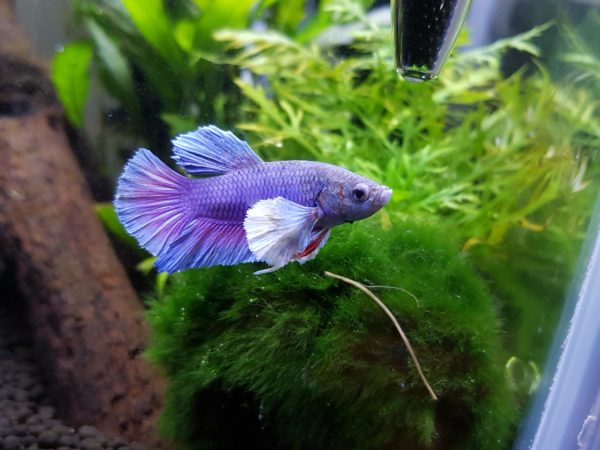
Again, do not forget to install a tank cover or lid, as many of these bettas tend to be jumpers and can jump to a distance of 2 to 3 inches or more. The easiest trick to identify a jumper is that their fins are pretty short. If you do not want to install a lid, keep a low water level.
The bettas are tropical fish and require a certain temperature range to thrive and flourish, i.e., 76-82 degrees Fahrenheit. If you live in a colder area, you can install a heater. The colder temperature may result in weakening your betta’s immune system.
Also, you need to pay attention to the pH as well. Generally, bettas love to have a neutral pH of 7.0. However. The acceptable range is between 6.8 to 7.4.
Besides pH, you should also focus on filtration. Bettas can survive in low-oxygen availability, but the water quality is of utmost importance. Poor quality affects betta’s health.
Betta Fish Tank Mates
The bettas are also known as Fighting fish because you cannot keep two bettas in one tank. Fish keepers keep their bettas alone. If you pair it with any other betta in a tank, these fish will fight.
But you can keep bettas in community tanks, but doing so can impose a potential threat on their beautiful tails.
However, you can keep bettas with –
Diseases
The bettas are susceptible to ich, constipation, fin rot, velvet, and fungal infections like any other freshwater fish.
To prevent them from catching any such diseases, take care of them by providing them with a proper diet and changing their water regularly. As these fish can be kept in a small tank, changing the water daily by 25% will not be a problem. If you cannot manage, you change the water by following a weekly routine.
For a single male Betta fish using a tank that is at least 5 gallons is highly advised. The female should be housed in a tank that is at least 10 gallons of water. Read more about betta fish here.
Endler’s Livebearer (Poecilia Wingei)

Originating from Venezuela’s Laguna de pos Patos, Cumana, this fish is one of the world’s best nano fish. These are tiny fish that grow 1 to 1.75 inch and have a 2 to 3 years life expectancy.
These fish as fast becoming a favorite amongst nano tank fish keepers. They can easily be kept by both the experienced and beginning aquarists. The males of this fish species have very bright colors with various patterns. The fish are known to breed very fast and can quickly populate a tank where they are kept. It is usually advisable for aquarists to rear just male fish and only go for females when they want to breed more of the fish. This is due to the fact they breed too fast and can quickly overpopulate the tank! These fish are very interesting to watch especially if they are kept in a transparent tank for they move about in every part of the tank showing off their beautiful colors.
Endler’s Livebearer Care And Tank Conditions
When it comes to Endler’s livebearers, they are pretty easy to keep and do not ask much to thrive. Yes, it requires no special treatment.
Based on where you live, you might want to get a heater; otherwise, the acceptable temperature for these fish is 76 – 84 degrees Fahrenheit. The pH needs to be around 6.5 to 8.0, and the water should contain less than 20ppm of nitrate, with 0ppm of nitrite and ammonia.
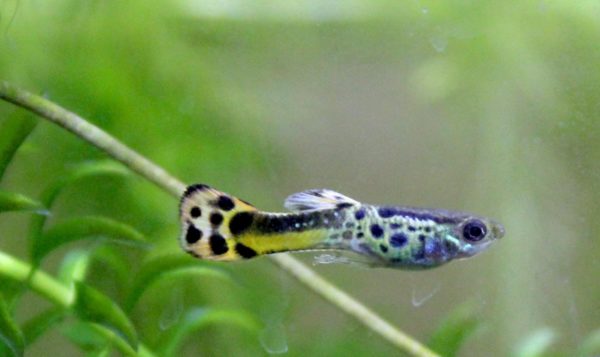
Do not install a powerful filtration system, as the fish are pretty small. Getting a filter that runs on a moderate power should be sufficient.
These fish do not necessarily need light, but plants in the tank need light. And these go well with any substrate and decors!
Endler’s Livebearer Temperament
These fish not just have beautiful colors, but also they have beautiful personalities! Endlers are social and love to co-exist with the fish of their kind. They would live a happy life if you kept them in six schools or more!
They often spend most time moving about the tank, and these are surface dwellers and incredibly active and outgoing.
Endler’s Livebearer Tank Mates
No matter how large your tank is, once you put the Endlers in it, they will utilize all the space in your tank. They are social, active, and outgoing.
These often form a great pair with Celestial Pearl Danio and Guppies. Endlers have similar care parameters to Guppies.
Another fantastic tankmate for your Endlers can be Corydoras. The Corydoras and Endlers go great due to similar care requirements, and both are among the best nano species.
Next comes Shrimps and Snails as they do not trouble any other fish in the tank. And the shrimps and snails come in various colors and sizes. All in all, it would make a good pair!
Strictly avoid putting turtles, crayfish, or cichlids as they can pose potential threats to your Endlers!
Diseases
Like every other freshwater fish, the Endler’s Livebearers are also susceptible to specific diseases, such as ich, fin, and tail rot.
If your fish has ich, you can easily identify them as these are external parasites that almost appear like grains of salt on the fish’s body.
The Endlers have stunning fins as they grow, but the fact is that you cannot safeguard them from fin rot and tail rot. You can identify this disease by blackening tips and gradually receding fins.
Are these diseases treatable? The best way to prevent your fish from infection and diseases is to change their water regularly. If regular water change sounds hard, you can do it once a week.
If they do not improve and spread rapidly, you should quarantine the affected fish in no time.
Read our guide on Endler.
The Asian Stone Catfish (Hera jerdoni)
Originating from Southeast Asia, these fish species are a great pick if you wish to add something new to your tank! One can easily find these fish in India and Bangladesh. It grows about 1.2 to 1.4 inches in length, which is pretty small.
Here is what you need to know about these fish –

The Asian Stone Catfish is yet another great choice fish for nano tanks thanks to its tiny size which will only be slightly over one inch at maturity. It is a type of Nano fish that will mostly spend much of its time relaxing at the bottom part of the tank. Feeding it is quite easy because it will readily accept a variety of food. You can feed it dried fish pellets, frozen food, No products found., daphnia, tubifex worms, and blood worms.
It is a relatively peaceful fish that will not mind living in the same nano tank with other peaceful fish species in the same tank. You can keep it alone in the tank but it will find excitement when kept in a group of at least five. Provide lots of hiding places for the catfish by placing things like drift wood, almond leaves, and softer substrate. Ensure that the water in the tank is kept clean and well oxygenated for the fish to survive in there. Because the fish is nocturnal, it is best to offer it food when the tanks light have been switched off.
Asian Stone Catfish Behavior
It is a very peaceful fish that spends most time relaxing right at the bottom of the tank or any other surface!
Not at all picky when it comes to food. Just provide some hiding places, and observe what this fish does!
Asian Stone Catfish Care And Tank Conditions
The Asian Stone Catfish does not require much space. A 10-gallon tank is sufficient for them to thrive. Yes, you can house a school of these fish inside such a small tank.
The stone catfish needs clean and clear water to live. Slightly cool water should be the best! Arrange pumps, as they need a good amount of oxygen.
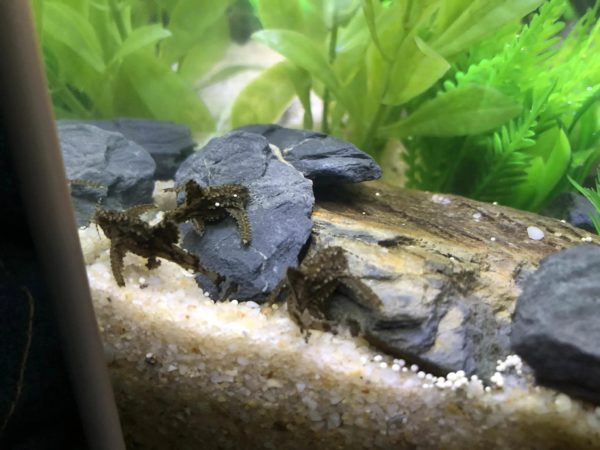
Ensure that the pH of the tank water is between 5.6 and 7.6, where you will keep the fish. The minimum tank size for keeping a single stone catfish should be at least 5 gallons of water.
Asian Stone Catfish Tank Mates
The Asian Stone Catfish are very peaceful and excellent for community tanks. It can co-exist with a variety of fish species, but it would be best if you also keep a group of these fish in your community tank. These fish love to hang out in groups!
This fish can be very compatible with other fish that can thrive in similar water conditions such as –
- Celestial Pearl Danio
- Scarlet Badis
- Golden Dwarf Gourami
- Mosquito Rasboras
- Cloud Minnows
- Adult Dwarf Shrimp
- Farlowellas
One thing to consider is that the stone catfish should be the only bottom dweller in the tank!
Asian Stone Catfish Diseases
Like other bottom-dwelling fish, this species is susceptible to diseases such as fungal and bacterial infections.
Ich is the most common disease that bottom-dwelling fish face, and it can be lethal if not treated and is very contagious. If any of your fish gets infected with a disease, do not spend more time thinking, and just quarantine them in a separate tank. Regular or routine cleaning of tanks can prevent such diseases.
Pygmy Cory Cats (corydoras sp)

These tiny Nano Fish originate from the South American region. Pygmy Cory Cats will grow to a maximum of just one inch in length at maturity. They are usually peaceful and like schooling therefore they need to be kept in groups of at least four or above in a single tank. It is interesting to note even different species of corydoras will still school together when kept within one community tank. They prefer to swim in the mid water sections of the tank unlike majority of their counterparts from other species that are known to be bottom dwellers.
You can feed live foods such as tubifex and live worms but they can also be fed frozen foods as well. Keep the pH of the tank water to between 6.5 and 7.6 for the fish to live a better life.
Pygmy Cory Cats Care And Tank Conditions
The cory cats are one of the most loved species worldwide. These are pretty small fish species that entertain you whenever you get close to your tank!
These lovely fish do not need any special treatment and can thrive if you fulfill their necessities. They can adapt to specific water conditions but needs attention if you want to keep them happy.
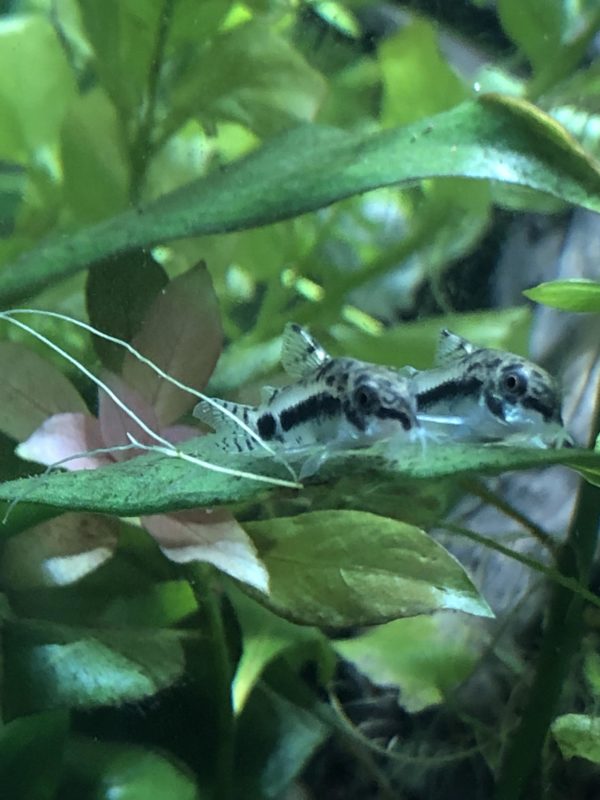
They do not need a pretty large tank. If you wish to keep a school of five to six cory cats, a 10-gallon tank should be enough.
The water in the tank should have a moderate flow since it cannot adapt to various water conditions. Hence, you need to keep the water parameters in check – the pH should be around 6.5 to 7.6, and the water hardness should be anywhere between 6 to 10 dKh.
Pygmy Cory Cats Behavior
These fish are known for their social and outgoing behavior. These species are not the type of fish who would behave aggressively to other fish in the tank.
You may see them fighting, but that is a gesture of playfulness. They always play here and there, and if you get to see some playful fights, you will enjoy it!
They can easily cohabitate with others! It is what makes them a great choice for community tanks.
Pygmy Cory Cats Tank Mates
Cory cats are peace-loving and face no issues when co-existing with other fish unless there is a big and aggressive fish around.
This fish is also a great choice for community tanks, and if you are planning to make a community tank, you must include these teeny-tiny peace-loving fish. However, the community should include gentle and peace-loving fish.
Some of the best tank mates for these fish can be –
- Neon Tetras
- Ember Tetra
- Dwarf Gourami
- Zebra Danio
- Khuli Loach
- Guppies
- Molly Fish
- Hatchetfish
- Chinese Algae Eater
- Cherry Barb
- Otocinclus
- Apistogramma
Not only these, but you can also pair your cory cats with shrimps and snails. However, if you want your cory cats to live fully and flourish, keep them in a group of at least six.
The larger the group, the more playful they get.
Pygmy Cory Cats Diseases
Being a freshwater fish, there are higher chances that cory cats would suffer from the same diseases as other freshwater fish.
According to reports, the Cory Cats are susceptible to red blotch disease. You can identify this disease when you see bloody sores over your fish’s body.
This disease is primarily the result of stress. Any fish is likely to get stressed when under poor water conditions.
If the water quality drops down, they can also suffer from ich, weakening your fish’s immune system. The ich disease can cause serious problems, as it is lethal and contagious. You can immediately quarantine any fish affected with ich.
Regular water check-ups can help you prevent your fish from such contagious diseases.
Frequently Asked Questions
What Are The Best Fish Species For A 5-Gallon Tank?
The best choices you can make for your 5-gallon tank are –
What Is A Nano Fish?
Nano fish are the fish species that can grow less than two inches in length and the species that can thrive happily in a small tank such as a 5 to 10-gallon tank!
Do I Need To Install A Filter In My Nano Tank?
Filtration is very necessary for any size tank! Filtration is even more important in the case of a nano tank.
Nano tanks are pretty small in size and require major maintenance! Just because it is a small tank does not mean it won’t require a filtration system!
Conclusion
Now that you read about our top five nano fish, which one are you picking?
No matter which one you pick, I bet you will be happy owning them. These are great fish species and are very popular worldwide, yet easy to maintain!Keep the maintenance and parameters in check, and you are good to go!
No related posts.
